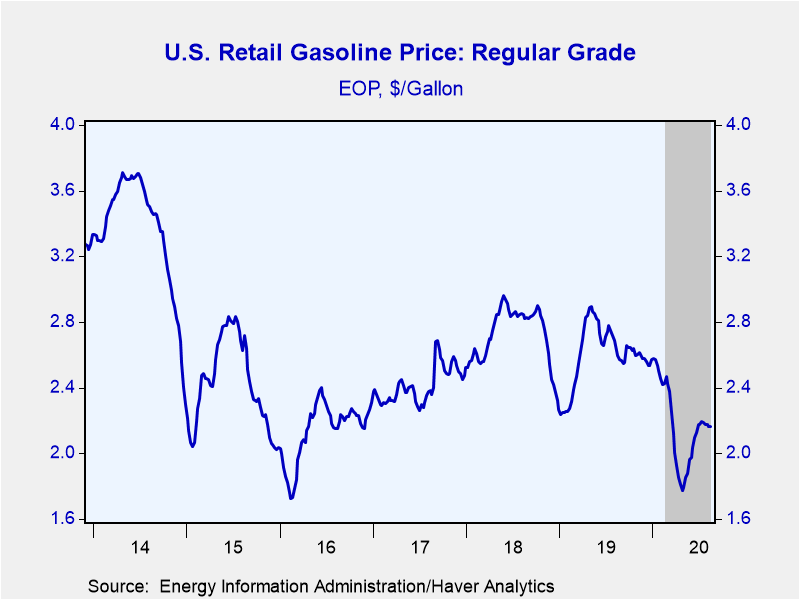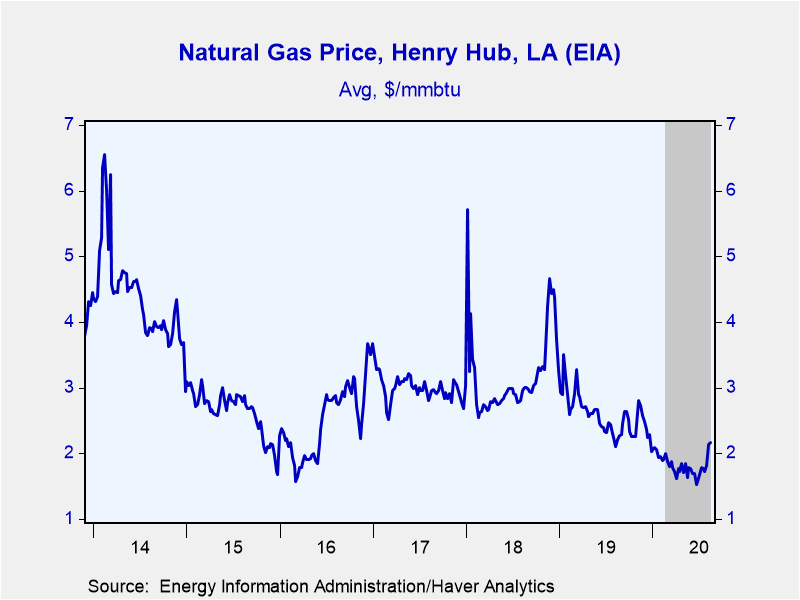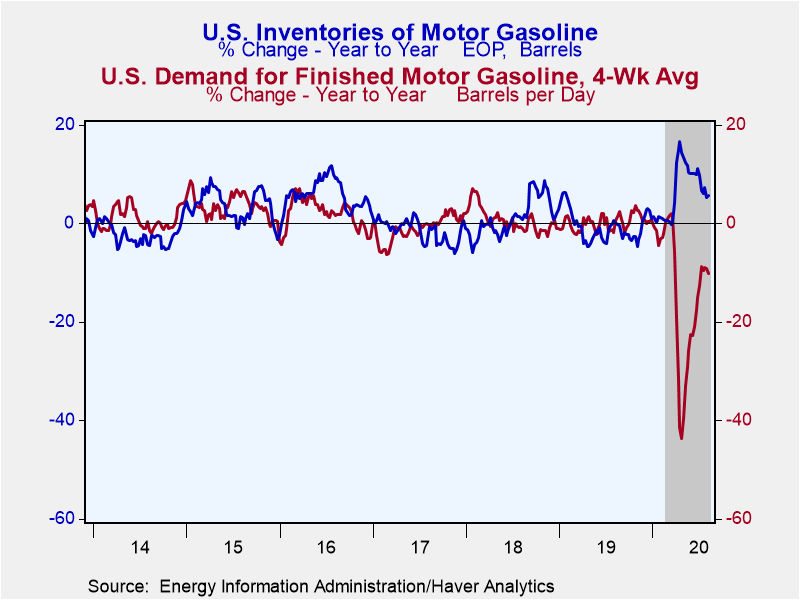 Global| Aug 18 2020
Global| Aug 18 2020U.S. Gasoline Prices Steady; Other Energy Prices Edged Up
by:Sandy Batten
|in:Economy in Brief
Summary
• Gasoline prices unchanged. • Crude oil prices edged up. • Natural gas prices rise to highest level since December 2019. Regular gasoline prices were unchanged at $2.17 per gallon (-16.6% y/y) in the week ended August 17. Prices have [...]
• Gasoline prices unchanged.
• Crude oil prices edged up.
• Natural gas prices rise to highest level since December 2019.
Regular gasoline prices were unchanged at $2.17 per gallon (-16.6% y/y) in the week ended August 17. Prices have been fairly steady since late June, remaining near the highest level since just prior to the COVID-19 lockdowns. Apple driving data has risen to levels slightly higher than just before the lockdowns, implying that demand for gasoline should be returning to pre-lockdown levels. Haver Analytics adjusts the gasoline price series for usual seasonal variation. Seasonally adjusted prices were also unchanged in the week ended August 17 at $2.13 per gallon.
The price for a barrel of West Texas Intermediate crude oil edged up to an average of $42.08 per barrel (-23.9% y/y) in the week ended August 14 from $41.56 per barrel in the previous week. Prices remained below early March, ahead of the lockdowns, when they touched $45.35 per barrel. Yesterday, the price was $42.89 per barrel. The price of Brent crude oil rose to $44.54 per barrel (-23.5% y/y) last week from $44.36 per barrel in the previous week. Yesterday, the price was $44.91 per barrel.
The average price of natural gas rose to $2.17/mmbtu (-1.8% y/y) in the week ended August 14, the third consecutive weekly increase, after having jumped to $2.13/mmbtu in the previous week. It was the highest weekly price since December 2019. Yesterday, the price rose further to $2.32/mmbtu, the highest price since December 5, 2019.
In the four weeks ending August 7, gasoline demand declined 10.2% y/y. Total petroleum product demand fell 14.3% y/y. Crude oil input to refineries was down 15.9% y/y in the past four weeks, but it has risen sharply since mid-May. Gasoline inventories were 5.7% above a year ago and inventories of all petroleum products were 7.6% higher than a year ago.
These data are reported by the U.S. Department of Energy. The price data can be found in Haver's WEEKLY and DAILY databases. Greater detail on prices, as well as the demand, production and inventory data, along with regional breakdowns, are in OILWKLY.
| Weekly Energy Prices | 08/17/20 | 08/10/20 | 08/03/20 | Y/Y % | 2019 | 2018 | 2017 |
|---|---|---|---|---|---|---|---|
| Retail Gasoline ($ per Gallon Regular, Monday Price, End of Period) | 2.17 | 2.17 | 2.18 | -16.6 | 2.57 | 2.27 | 2.47 |
| Light Sweet Crude Oil, WTI ($ per bbl, Previous Week's Average) | 42.08 | 41.56 | 40.73 | -23.9 | 56.91 | 64.95 | 50.87 |
| Natural Gas ($/mmbtu, LA, Previous Week's Average) | 2.17 | 2.13 | 1.82 | -1.8 | 2.57 | 3.18 | 2.99 |
Sandy Batten
AuthorMore in Author Profile »Sandy Batten has more than 30 years of experience analyzing industrial economies and financial markets and a wide range of experience across the financial services sector, government, and academia. Before joining Haver Analytics, Sandy was a Vice President and Senior Economist at Citibank; Senior Credit Market Analyst at CDC Investment Management, Managing Director at Bear Stearns, and Executive Director at JPMorgan. In 2008, Sandy was named the most accurate US forecaster by the National Association for Business Economics. He is a member of the New York Forecasters Club, NABE, and the American Economic Association. Prior to his time in the financial services sector, Sandy was a Research Officer at the Federal Reserve Bank of St. Louis, Senior Staff Economist on the President’s Council of Economic Advisors, Deputy Assistant Secretary for Economic Policy at the US Treasury, and Economist at the International Monetary Fund. Sandy has taught economics at St. Louis University, Denison University, and Muskingun College. He has published numerous peer-reviewed articles in a wide range of academic publications. He has a B.A. in economics from the University of Richmond and a M.A. and Ph.D. in economics from The Ohio State University.










